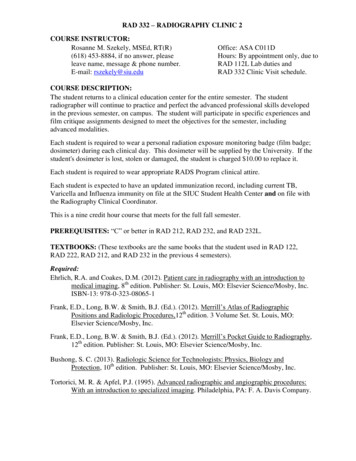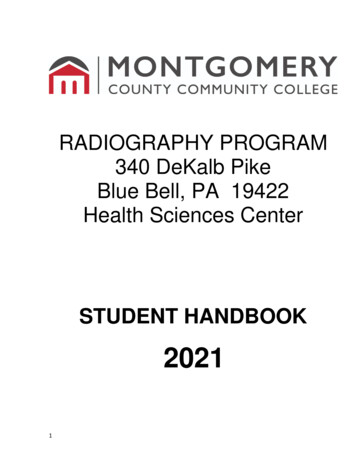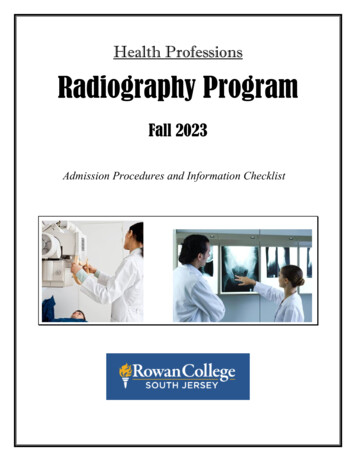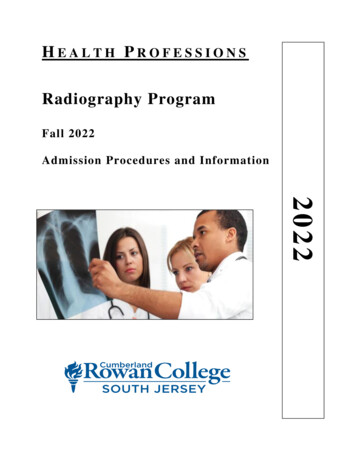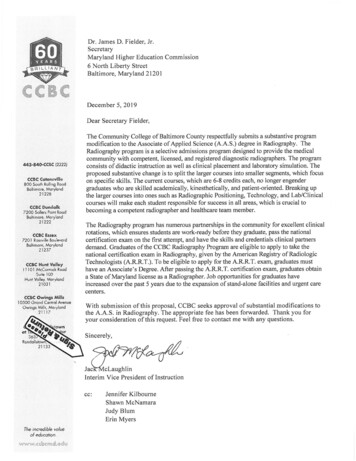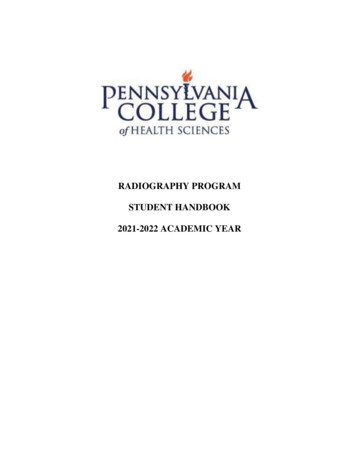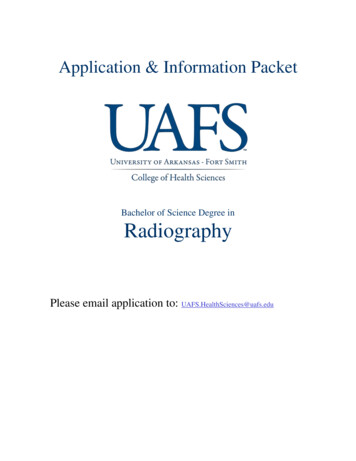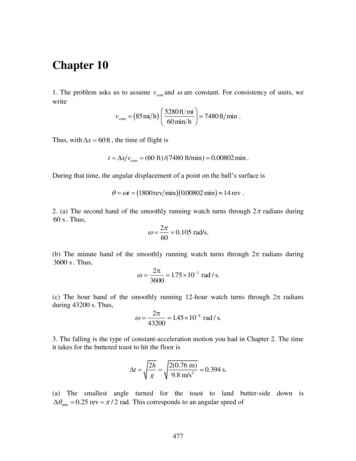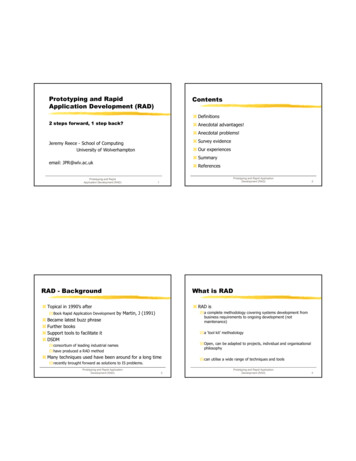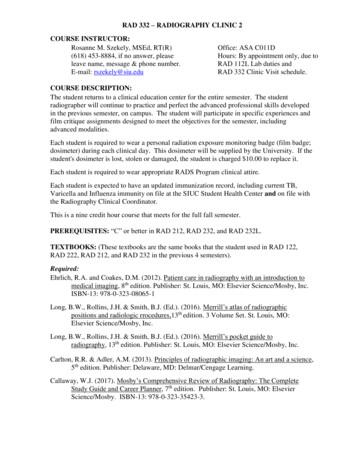
Transcription
RAD 332 – RADIOGRAPHY CLINIC 2COURSE INSTRUCTOR:Rosanne M. Szekely, MSEd, RT(R)(618) 453-8884, if no answer, pleaseleave name, message & phone number.E-mail: rszekely@siu.eduOffice: ASA C011DHours: By appointment only, due toRAD 112L Lab duties andRAD 332 Clinic Visit schedule.COURSE DESCRIPTION:The student returns to a clinical education center for the entire semester. The studentradiographer will continue to practice and perfect the advanced professional skills developedin the previous semester, on campus. The student will participate in specific experiences andfilm critique assignments designed to meet the objectives for the semester, includingadvanced modalities.Each student is required to wear a personal radiation exposure monitoring badge (film badge;dosimeter) during each clinical day. This dosimeter will be supplied by the University. If thestudent's dosimeter is lost, stolen or damaged, the student is charged 10.00 to replace it.Each student is required to wear appropriate RADS Program clinical attire.Each student is expected to have an updated immunization record, including current TB,Varicella and Influenza immunity on file at the SIUC Student Health Center and on file withthe Radiography Clinical Coordinator.This is a nine credit hour course that meets for the full fall semester.PREREQUISITES: “C” or better in RAD 212, RAD 232, and RAD 232L.TEXTBOOKS: (These textbooks are the same books that the student used in RAD 122,RAD 222, RAD 212, and RAD 232 in the previous 4 semesters).Required:Ehrlich, R.A. and Coakes, D.M. (2012). Patient care in radiography with an introduction tomedical imaging, 8th edition. Publisher: St. Louis, MO: Elsevier Science/Mosby, Inc.ISBN-13: 978-0-323-08065-1Long, B.W., Rollins, J.H. & Smith, B.J. (Ed.). (2016). Merrill’s atlas of radiographicpositions and radiologic rrocedures,13th edition. 3 Volume Set. St. Louis, MO:Elsevier Science/Mosby, Inc.Long, B.W., Rollins, J.H. & Smith, B.J. (Ed.). (2016). Merrill’s pocket guide toradiography, 13th edition. Publisher: St. Louis, MO: Elsevier Science/Mosby, Inc.Carlton, R.R. & Adler, A.M. (2013). Principles of radiographic imaging: An art and a science,5th edition. Publisher: Delaware, MD: Delmar/Cengage Learning.Callaway, W.J. (2017). Mosby’s Comprehensive Review of Radiography: The CompleteStudy Guide and Career Planner, 7th edition. Publisher: St. Louis, MO: ElsevierScience/Mosby. ISBN-13: 978-0-323-35423-3.
GENERAL COURSE OBJECTIVES:Upon completion of this course, and with 100% accuracy, the student shall be able to:1.Complete the Mandatory competency exams within Category 1 through 7.2.Observe and assist with exams during Advanced Modality rotations (Category 8).3.Maintain a clinical record notebook on a daily basis.4.Observe the radiologist interpreting radiographs.5.Maintain a clinical positioning journal for the examinations in the required categories.6.Identify any contrast material utilized for the appropriate examination.7.Identify patient preparation required for appropriate exam.8.Satisfactorily complete the orientation objectives in the following areas:(Please refer to these sections, under the guidelines for RAD 332, for the specificobjectives.)a.b.c.9.All Radiographic RoomsRadiology DepartmentHospitalSatisfactorily complete the 4 ARRT Radiography Self-Made study guides inpreparation to sit for the national ARRT Radiography certification exam in late Spring2017. Topics covered include:a.Patient Careb.Radiation Protection and Patient Safetyc.Image Productiond.Imaging ProceduresACADEMIC HONESTY:All students will to adhere to a strict code of academic honesty, according to the SIUCStudent Conduct Code.ACTS OF ACADEMIC DISHONESTY, from the “SIUC Student Conduct Code”, section IIViolations, article A (http://srr.siu.edu/ common/documents/SCC.pdf)A.Plagiarism, representing the work of another as one’s own work;B.Preparing work for another that is to be used as that person’s own work;C.Cheating by any method or means;D.Knowingly furnishing false information to a University official relative toacademic matters;E.Soliciting, aiding, abetting, concealing, or attempting conduct in violation ofthiscode.Penalties will be imposed for violations of this policy in accordance with the SIUC StudentConduct Code. These penalties may include one or more of the following disciplinarymeasures for a case of academic dishonesty: A grade of zero (0) for the assignment, lab, quiz or test.RAD 332 Rad. Clinic 22Fall 2016
Course grade dropped 1 letter grade. An “F” for the entire course. Recommendation of dismissal from the Program.DRESS CODE:Clothing is a form of non-verbal communication that reflects confidence in ability andjudgment, personal behavior and sense of professional image. Our patients' perceptions ofcompetence and professionalism of the radiographer are often based on first impressions.These impressions are then processed into stereotypical responses to the image theradiographer presents. Thus, the first impression of the radiographer in uniform is thestrongest statement of professionalism.It is essential as radiography faculty and students that we present ourselves as professionals.We must look and act in a manner that conveys authority and integrity. It is important to theoverall impression of our Program that we maintain a high standard of professionalism.Therefore, a strict dress code policy has been developed. This policy will be enforceduniformly and final authority for interpretation lies with the Program Director.See pages 24-26 in the student’s Diagnostic Radiography Clinical Handbook for a completediscussion of the RAD 332 Clinical Dress Code.METHODOLOGY:The final clinical grade in RAD 332 will be determined as follows:Competency Performance . . . . . . . . . . .40% (based upon completion of aminimum of 21 exams, includingProgram Required AdvancedModality rotations)Attitudinal Performance . . . . . . . . . . . .40%(based upon recommended 5th,10th, and 15th week Personal/Professional Growth Evaluations)Average grade on 4 Self-made RadiographyRegistry Study Guides .20% Added to the total weighted score.Attendance/Tardiness/Initiative Adjustment Added to the total weighted score.See pages 45-49 in the student’s Diagnostic Radiography Clinical Handbook for a discussionof the Clinical Competency Performance and the Behavior Evaluation (Personal/ProfessionalGrowth Evaluations).STUDENT EVALUATION & GRADING:The final clinical grade for RAD 332 is calculated as the sum of:o the weighted Competency average (Mandatory, Elective & Prog. Req. Adv. Mod.)o the weighted Performance Evaluation average,o the weighted Average grade on Radiography Study Guides, and,o any Attendance/Initiative adjustment.RAD 332 Rad. Clinic 23Fall 2016
ADVANCED MODALITY ROTATIONS (CATEGORY 8):During a four week special assignment period, the student will observe and assist in thefollowing Advanced Modalities:1.Ultrasound (Medical Sonography)2.C.T. Scanning (Computerized Tomography)3.Radiation Therapy (Radiation Oncology)4.MRI (Magnetic Resonance Imaging)Optional advanced modality rotations are Angiographic/Interventional procedures, BoneDensitometry, and Nuclear Medicine.In order to get proper Category 8 credit (that is, in order to ‘comp out’ in Category 8 advancedmodalities) for each advanced modality rotation, the student must: Write out the answers to the Objectives for the desired modality by the endof the week’s rotation; Ask the modality Clinical Supervisor/Clinical Instructor to complete themodality “Student Evaluation;” and, Hand in the completed modality Objectives and modality “Student Evaluation”to his/her University Clinical Coordinator, at the designated due date.There is a Clinical Instructor for each of the advanced modalities who is responsible forinsuring that students complete these objectives.Each student is expected to spend 37 hours (5 7.5-hour days), each, in these AdvancedModalities. Failure to complete the require hours in an Advanced Modality will have anegative effect on the student’s clinical grade for the semester.Chronic absenteeism from any Advanced Modality Rotation may result in the student beingterminated from the Program.The advanced modality objectives are located in APPENDIX E (starting on page 72 in thestudent’s Diagnostic Radiography Clinical Handbook).The RAD 332 clinical grade is reflected in the following grading scale.93 -100 A85 - 92 B75- 84 CBelow 75 F-Exceptionally high achievement and superior initiative.High achievement and above average initiative.Satisfactory achievement and average initiative.Unsatisfactory achievement and unacceptable initiative.Student does not progress to the next semester in the Program.Any competency category, not having the minimal number of completed competencies willresult in a semester grade of incomplete (INC). This incomplete must be completed by thestart of the next academic semester. Failure to complete an incomplete within the prescribedtime may jeopardize a student's progress within the Program.All Radiography students must pass each of their Radiologic Sciences prefix courses (RAD)with a grade of “C” or better in order to satisfy Program requirements, to graduate, and to passRAD 332 Rad. Clinic 24Fall 2016
the National Board Exam in Radiography. This grade of “C” or better is based upon theRadiologic Sciences grading scale.Any Radiography student that fails a Radiologic Sciences course will not continue in ourProgram. When course failure occurs, the student will meet with the appropriate facultymember and Academic Advisor to discuss the student's future educational plans/goals. Thisdiscussion will include referring the student to the University Career Services office(www.careerservices.siu.edu; Ph: 618-453-1036) for testing via the “Strong InterestInventory” and the “Meyer-Briggs Personality Inventory” to identify the academic majors thatbest fit the student’s personality, values, interests, and skills.ADA Accommodations:If you think you have a learning disability or know you have a disability but have not beentested, then please contact SIUC Disability Support Services at 453-5738 for an appointmentfor the evaluation of your learning disability.If you do not notify us (prior to the end of the first week of the semester) that you have adisability, and you do not request accommodation during this course, then you accept fullresponsibility for your own success or failure in this course. Ultimately, YOU are responsiblefor your own success or failure and the resulting consequences.CLINCAL PAPERWORK DEADLINES:In order to properly record and grade the Mandatory and Elective Comps for each student, thefollowing schedule is established.a. On or before the first Friday in September (Sept. 2, 2016), these items are due:o RAD 332 Appendix A Understanding of Clinical Responsibilitieso RAD 332 Appendix C-1 Hospital Policy Manual and Department Orientation Formo RAD 332 Appendix C-2 Receipt of Clinical Syllabus, Handbook & UnderstandingOf Clinical Policies.o Receipt and Understanding of RAD 332 Syllabus, Radiography General Policies &Radiography Clinical Education Policieso RAD 332 MRI Safety Screening Protocolb. On or before the last Friday in September (Sept. 30, 2016), these items are due: The 1st Behavior Evaluation, reviewed, discussed and signed by student andClinical Supervisor; 3-6 Mandatory Comps; 3-4 Elective Comps; Self-made Study Guide #1 on Patient Care: Education, Interactions & Management.c. On or before the last Friday in October (Oct. 28, 2016), these items are due:The 2nd Behavior Evaluation, reviewed, discussed and signed by student andClinical Supervisor;3-6 Mandatory Comps;RAD 332 Rad. Clinic 25Fall 2016
3-4 Elective Comps;Self-made Study Guide#2 on Radiobiology & Radiation Safety.d. On or before the last Friday in November (Nov. 25, 2016), this item is due: Self-made Study Guide #3 on Image Production: Image Acquisition, Evaluation,Equipment Operation & Quality Assurance.e. By 12noon on Tuesday of Final Exam week (December 13, 2016), these items are due: All remaining Mandatory Comps; All remaining Elective Comps; Self-made Study Guide #4 on Imaging Procedures Any remaining Behavior Evaluations, reviewed, discussed and signed by studentand Clinical Supervisor; and, Other items will be due at the end of the semester and will be discussed under separatecover.Please note: the Mandatory and Elective Comps can be from exams in Categories 1-7, on yourRAD 222/332 Competency Checklist. RAD 222 is Radiography Clinic 1—Spring 2016 semester; RAD 332 Radiography Clinic 2—Fall 2016 semester.CONSEQUENCE OF MISSING A DEADLINE: The consequence of missing one of the known Fall 2016 deadlines is that the student’sRAD 332 clinical grade is decreased by 1 letter grade. Miss 2 deadlines and the student’s RAD 332 clinical grade drops 2 letter grades. If a student ignores all the deadlines, and then hands in all of his/her clinicalpaperwork at the end of the semester (12noon on Dec. 15, 2016), then that student willget an "F" in RAD 332.I know this set of consequences sounds harsh. But you are adults, and you are expected totake responsibility for your own actions. (Forgetting and/or ignoring a known deadline IS anaction. Actions have consequences).A few of you may be asking yourself, “ why have these deadlines in the first place ?”That’s easy to answer. When I receive your clinical paperwork in small batches throughoutthe semester, it’s easier to grade and helps me keep track of your completed exams.ATTENDANCE:During the clinical semesters, each student is required to attend to his/her clinical internshipsite Monday through Friday during assigned clinical hours, for thirty-seven hours (37) perweek, for the entire semester. Lunch time is excluded in the calculation of clinical hours.Assigned clinical hours may be dayshift (E.g. M-F, 8am-3:30 pm) or evening shift (E.g. M-F,3pm-10:30pm).During each clinical semester, there are scheduled clinical days. All absences must be madeup. A make-up schedule will be determined by the Clinical Instructor in conference with theRAD 332 Rad. Clinic 26Fall 2016
appropriate RADS faculty member. The only exceptions to this will be made at the ClinicalInstructor's discretion. No competency testing may be performed on make-up days!Even though the student makes up all absences, chronic absenteeism is not acceptable and itwill have a negative impact on the student’s clinical grade. Therefore, any Radiographystudent who demonstrates chronic absenteeism will incur the following penalty: his/herclinical grade is decreased by 20 points.Please note: Any student who is absent from the clinical site due to illness, ANDfollows Program procedures for daily calling in the absence, is NOT penalized forchronic absenteeism.Pages 20-22, and page 48 in the student’s Diagnostic Radiography Clinical Handbookdescribe the RADS 332 Attendance Policy in greater detail.During the semester, if a student chooses to drop out of the Radiologic Sciences Program, orthis course, that student must meet with the course instructor to discuss the student's reasonsfor leaving the course.Keep in mind that dropping below "full-time" status will jeopardize the student's bank loans,financial aid, scholarships, Veterans benefits, housing, academic standing, time to degree,athletic status and/or international student visa. Since thoughts and feelings often influence astudent's behavior and academic performance, any student having doubts or second thoughtsabout continuing in this Program should talk to any of the Radiologic Sciences faculty.School CalendarAll students will follow the SIUC school calendar for the start/end of the semester,Thanksgiving break, and other University recognized holidays.Fall semester begins August 22, 2016 and extends through December 9, 2016.Labor Day Holiday: September 5, 2016Fall Break: October 8-11, 2016; Return to Clinic on October 12, 2016Veterans Day: November 11, 2016;Thanksgiving Break: November 23-27, 2016 (Wednesday-Sunday)Final Exam Week: December 12-16, 2016Winter Graduation: December 17, 2016, SIUC ArenaSpring 2017 semester begins January 17, 2017 and extends through May 5, 2017.Martin Luther King, Jr. Birthday: January 16, 2017Spring Break: March 11-19, 2017Spring Final Exam Week: May 8-12, 2017Spring Graduation: May 13, 2017, SIUC ArenaEarliest date to sit for ARRT Radiography Board Exam: May 15, 2017.You MUST take and pass the ARRT Radiography Board Exam by July 1, 2017.Your Advanced Modality classes and labs begin August 21, 2017.For additional important dates for all SIUC students, please see the Fall 2016 syllabusattachment on the SIUC Provost’s website:www.pvcaa.siu.edu/ RAD 332 Rad. Clinic 27Fall 2016
Inclement Weather PolicyShould unsafe weather conditions occur, the student must use discretion in traveling tothe clinical site. If staying off the road is the best decision, then the student must contact theClinical Instructor/Clinical Supervisor immediately (within the first 30 minutes of his/hershift) to explain his/her absence. On the student’s Time Sheet, please mark it as “SN-Excused”. The rationale for this policy is that calling the Clinical Instructor/Clinical Supervisorto explain the absence, shows respect, professional courtesy, and it demonstrates thedesirable character quality of taking responsibility for one’s own actions.If the student doe s not call-in (within the first 30 minutes of his/her shift) to explain his/herabsence, then the absence is not excused and the student must make up the clinical time. On the student’s Time Sheet, please mark it as “SN-Not Excused”. The rationale is that by not calling the Clinical Instructor/Clinical Supervisor toexplain the absence, the student is showing the undesirable character traits ofpresumption and irresponsibility. If the student calls in later in the day, then the absence is still not excused, the studentmust make up the clinical time, and the student’s Time Sheet is marked “SN-NotExcused”.If bad weather (snow, ice, flooding, tornado, earthquake, etc.) occurs on a clinical day, thestudent is responsible for finding out if the local university in the clinical site area is closed.This reference site must be coordinated with your Clinical Instructor the first week ofclinical. If that local university is closed due to hazardous road conditions, then the student isexcused from going to clinical even though SIUC may be open. The student must write“Snow Day” on this/her Time Sheet, and this absence will be verified by the ClinicalSupervisor.The student is still expected to call in, to the Clinical Instructor or his/her designee, within 30minutes of the student’s regular starting time, to explain the absence.If the local university is open, but the student cannot get to his/her clinical site, then he/shemust make up the day. The student is still expected to call in, to the Clinical Instructor orhis/her designee, within 30 minutes of the student’s regular starting time, to explain theabsence.Please note: All unexcused “snow days” must be made-up. If the public elementary schoolsare closed due to temperature extremes (frigid cold, oppressive heat, etc.), then the SIUCRadiography student is still expected to go to clinical as originally scheduled.RAD 332 Rad. Clinic 28Fall 2016
APPENDIX ARAD 332UNDERSTANDING OF CLINICAL RESPONSIBILITIESI, hereby acknowledge that I have read andunderstand the contents of this student handbook and agree to abide by these policies as statedor be subject to University recourse.1.2.List the departmental or hospital intercom/phone code for:a.A patient experiencing cardiac or respiratory arrest.b.Assistance with a violent patient, family member or visitor.c.A fire noticed within the department or hospital.d.A weather emergency or natural disaster (tornado, earthquake, mine explosion,massive auto accident, bomb explosion).List the name(s) of your Clinical Instructor(s).Student SignatureDateSupervising Clinical InstructorDate*To be kept in the student’s file at the program office.RAD 332 Rad. Clinic 29Fall 2016
APPENDIX C-1 – RAD 332 – Radiography Clinic 2HOSPITAL POLICY MANUALandDEPARTMENT ORIENTATION FORMI, have read and understand the Hospital PolicyManual at . I agree to acknowledge and abideby the policies in the manual ofHospital/Clinic. If I do not abide by the policies as stated, I understand that I will be subjectto expulsion from the clinical site.I also have been given a hospital orientation as well as a Radiology Departmentorientation. The purpose of these orientations is to familiarize myself with the following: hazards (fire, electrical, chemical); emergency preparedness; medical emergencies within the Imaging department; HIPAA; Standard Precautions; professional clinical attire (dress code); locations of various departments throughout the hospital; the hierarchy of the Radiology/Imaging Department; personal cell phone use in the Radiology/Imaging Department; personal use of the computer in Radiology/Imaging Department; image processing; the patient flow procedure from the beginning paperwork through image filing system and; the routine protocols and procedures of this Imaging department.Finally, I have successfully completed the hospital orientation objectives and theradiology department objectives as these pertain to my assigned clinical site. Theseobjectives are stated in Chapter 3 of the Diagnostic Radiography Clinical Evaluation Manual.Student SignatureDateSupervising Clinical InstructorDateRAD 332 Rad. Clinic 210Fall 2016
APPENDIX C-2 – RAD 332 – Radiography Clinic 2RECEIPT OF CLINICAL SYLLABUS AND CLINICAL HANDBOOKandUNDERSTANDING OF CLINICAL POLICIESI have received a copy of the syllabus for the course RAD 332 Radiography Clinic 2.The instructor has explained the contents and I have an understanding of the policiescontained in the syllabus and in the Radiography Clinical Handbook, including but notlimited to: Attendance; Tardiness; Daily clinical hours; Clinical absences; Clinical make-up days; Cell phone use; Hospital computer use; Radiography Program dress code; Competency examinations; Advanced modality rotations; and, Clinical grading policyI understand the Program faculty, University administration, and/or RadiographyAdvisory Committee members may review written assignments and/or clinical competencyexams submitted by me.Student SignaturePrint Student NameDate
MAGNETIC RESONANCE (MR) SAFETY SCREENING PROTOCOLMagnetic resonance imaging, or MRI, is a way of obtaining very detailed images oforgans and tissues throughout the body without the need for x-rays or "ionizing" radiation.Instead, MRI uses a powerful magnetic field, radio waves, rapidly changing magnetic fields, anda computer to create images that show whether or not there is an injury, disease process, orabnormal condition present. For the MRI procedure, the patient is placed inside the MRscanner—typically a large, tunnel or doughnut-shaped device that is open at both ends. Thepowerful magnetic field aligns protons that are present in most of the body's tissues. The appliedradio waves then cause these protons to produce signals that are picked up by a radio frequencyreceiver (RF receiver) within the MR scanner. The signals are characterized using the rapidlychanging magnetic field, and, with the help of computer processing, very clear images of tissuesare created as "slices" that can be viewed in any orientation.The powerful magnetic field of the MR system will attract iron-containing (also known asferromagnetic) objects and may cause them to move suddenly and with great force. This poses apossible risk to the patient or anyone in an object's "flight path." Great care is taken to be certainthat objects such as ferromagnetic screwdrivers and oxygen tanks are not brought into the MRsystem area.In a similar manner, smaller iron-containing objects such as certain medication pumps,medication patches, or aneurysm clips may move suddenly and with great force, when in thepresence of powerful magnetic fields of an active MRI scanner. Such forceful motion maydamage the device, cause the device to malfunction or cause personal injury.Every MRI facility has a comprehensive patient screening procedure and protocol that,when carefully followed, ensures that the MRI technologist and radiologist knows about thepresence of metallic implants and materials so that special patient imaging precautions can betaken. For example:o Due to the presence of an unacceptable implant or device, the exam may becanceled.o The MRI exam will not be performed if a ferromagnetic aneurysm clip is presentbecause there is a risk of the clip moving or being dislodged.o Certain medical implants can heat substantially during the MRI examination as a result ofthe radiofrequency energy that is used for the procedure.
Before an MRI exam the patient is asked to fill out a screening form asking about anything thatmight create a health risk or interfere with imaging. Items that may create a health hazard orother problem during an MRI exam include: Cardiac pacemaker or implantable defibrillator;Catheter that has metal components that may pose a risk of a burn injury; A ferromagnetic metal vascular clip placed to prevent bleeding from an intracranialaneurysm; An implanted or external medication pump (such as that used to deliver insulin or a painrelieving drug); A cochlear (inner ear) implant; A neurostimulation system; A catheter that has metallic components that may pose a risk of a burn injury.Objects that may interfere with image quality if close to the area being scanned include: Metallic spinal rod Metallic microfibers (threads) imbedded in the fabric of athletic clothing Plates, pins, screws, or metal mesh used to repair a bone or joint Joint replacement or prosthesis Metallic jewelry including those used for body piercing Some tattoos or tattooed eyeliner (these alter MR images, and there is a chance of skinirritation orswelling; black and blue pigments are the most troublesome) Makeup, nail polish or other cosmetic that contains metal Bullet, shrapnel, or other type of metal fragment Metallic foreign body within or near the eye (such an object generally can be seen on anx-ray; metalworkers are most likely to have this problem) a bullet or other metallic fragment in your body (e.g., any metallic foreign body) there isapotential risk that it could change position, possibly causing personal injury. Dental fillings (while usually unaffected by the magnetic field, they may distort imagesof the facial areaor brain; the same is true for orthodontic braces and retainers)As an SIUC Radiologic Sciences student, you may have an occasion to assist withmoving a patient into or out of the MRI scanner, it is vital that you remove all metallic objects inadvance of entering the MRI scanning room, including watches, jewelry, and items of clothingRAD 332 RAD Clinic 2 Syllabus13Fall 2016
that have metallic threads or fasteners. Items that need to be removed by SIUC Radiologicstudents before entering the MR system room include, and are not limited to: Purse, wallet, money clip, credit cards, cards with magnetic strips; Electronic devices such as beepers or cell phones; Hearing aids; dosimeter (film badge) holder; Metal jewelry, watches , safety pins; Pens, metal spiral notebook, paper clips, keys, coins; and, Hair barrettes, hairpins, Program name pin. Metallic microfibers (threads) imbedded in the fabric of a T-shirt.Removal of these items is for the safety of yourself, the patient, and the Imaging personnelaround you.Additionally, if an SIUC Radiologic Sciences student has on, or within his/her body, anyof the previously listed hazardous or interfering devices, then the Radiologic Sciences facultyhave developed an MRI Safety Screening Protocol form, located on page 86. This form and thecontent of the previous pages is to provide appropriate safety information pertaining to magneticfields and radiofrequency hazards.While assisting in the MR environment, should an SIUC Radiologic Sciences student feelany intolerable pulling, unnatural heat or burning sensation within himself/herself then thestudent must leave the MR environment as quickly as possible, to prevent personal injury.During each clinical orientation, the radiologic student will need to fill out the MRISafety Screening Form and sign the form BEFORE attending the respective clinical semester.RAD 332 RAD Clinic 2 Syllabus14Fall 2016
MAGNETIC RESONANCE (MR) SAFETY SCREENING PROTOCOLFor the RAD 332 StudentWARNING:An MR room has a very strong magnetic field that may be hazardous to individuals entering theMR environment if they have certain metallic, electronic, magnetic, or mechanical implants,devices, or objects. Therefore, all students are required to fill out this form before going to theirclinical internship. Be advised, the MR system magnet is ALWAYS on.While assisting in the MR environment, should an SIUC Radiologic Sciences student feel anyintolerable pulling, unnatural heat or burning sensation within himself/herself then the studentmust leave the MR environment as quickly as possible, to prevent personal injury.Do not enter the MR environment or MR system room if you have any question or concernregarding an implant, device, or object.Please indicate if you have any of the following known MR hazardous devices: Aneurysm clip(s) Cardiac pacemaker Implanted cardioverter defibrillator (ICD) Electronic implant or device Magnetically-activated implant or device Neurostimulation system Spinal cord stimulator Cochlear implant or implanted hearing aid Insulin or infusion pump Implanted drug infusion device Any type of prosthesis, implant or tattoo Artificial or prosthetic limb Any metallic fragment, foreign body, or piercing Any external or intern
Radiologic Sciences grading scale. Any Radiography student that fails a Radiologic Sciences course will not continue in our Program. When course failure occurs, the student will meet with the appropriate faculty member and Academic Advisor to discuss the student's future educational plans/goals. This
